The physics of how gas accretes onto supermassive black holes is hugely important in astrophysics. It is a difficult topic of research however, involving three-dimensional, hot, magnetic plasmas. In a 2017 study, we used the G1 and G2 gas clouds in the Galactic center as probes of the accretion flow around SgrA*. As they plunge through the background gas, their orbits change due to dynamical friction. By analyzing these changes, we showed that the rotation axis of the accretion flow points along that of the Galaxy and of a putative jet! We also found that the pericenter passage date of G2 was delayed, due to precession of its eccentricity vector. It likely occured in August 2014, several months after the G2 observing campaign ended. Interestingly, this coincided with an increase in both the rate and luminosity of X-ray flares from SgrA*.



 The Physics Frontiers Centers (PFC) program supports university-based centers and institutes where the collective efforts of a larger group of individuals can enable transformational advances in the most promising research areas. The program is designed to foster major breakthroughs at the intellectual frontiers of physics by providing needed resources such as combinations of talents, skills, disciplines, and/or specialized infrastructure, not usually available to individual investigators or small groups, in an environment in which the collective efforts of the larger group can be shown to be seminal to promoting significant progress in the science and the education of students. PFCs also include creative, substantive activities aimed at enhancing education, broadening participation of traditionally underrepresented groups, and outreach to the scientific community and general public.
The Physics Frontiers Centers (PFC) program supports university-based centers and institutes where the collective efforts of a larger group of individuals can enable transformational advances in the most promising research areas. The program is designed to foster major breakthroughs at the intellectual frontiers of physics by providing needed resources such as combinations of talents, skills, disciplines, and/or specialized infrastructure, not usually available to individual investigators or small groups, in an environment in which the collective efforts of the larger group can be shown to be seminal to promoting significant progress in the science and the education of students. PFCs also include creative, substantive activities aimed at enhancing education, broadening participation of traditionally underrepresented groups, and outreach to the scientific community and general public.